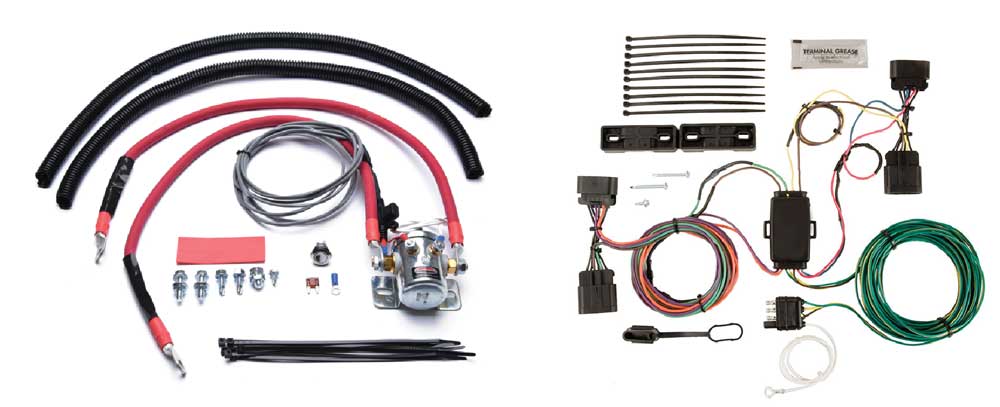How to set up a dinghy vehicle’s electrical system for safe, trouble-free towing
When you tow a vehicle behind a motorhome, you have to consider that you’re essentially treating the car like a trailer, and it should function like one in order to ensure safe, lawful travel. In the last two installments of Dinghy Digest, we presented information on baseplates and tow bars that make hitching and towing possible — so now it’s on to the next step: the electrical system.
Unlike a trailer, which has a power cord designed to plug into the tow vehicle to provide power for running/brakelights and turn signals, a car/truck/SUV doesn’t, so one must be wired into the system. The most common way to do this is with a wiring harness that plugs/splices into the dinghy vehicle’s tail- and brakelights and uses one-way diodes to prevent electrical feedback. For those who prefer not to tap into the existing wiring, a bulb and socket kit can be used, which bypasses the towed vehicle’s lighting circuit and is mounted inside the taillight assemblies. In either example, the wiring harness is routed to a receptacle mounted at the front of the vehicle, and a specific power cord is plugged into the dinghy and motorhome, in a similar fashion to hooking a trailer to the tow vehicle.
Years ago, those were your only two options — but today, there are even easier alternatives. Blue Ox, Demco and Hopkins Towing Solutions offer vehicle-specific wiring harnesses for popular vehicles that allow you to plug into the factory harness, eliminating the need for cutting and splicing. These same companies offer fit lists that make it easy to determine if a vehicle-specific kit is available for your application.

Above left, Demco offers vehicle-specific plug-in wiring kits as well as Bulb Taillight Wiring and diode wiring kits (like this one) that employ heat-sealed diodes to connect the motorhome’s running lights, turn signals and brakelights to the towed vehicle. Diodes prevent the backflow of electricity to protect both vehicles’ electrical systems.
Above middle, Hopkins Towing Solutions offers vehicle-specific towed vehicle wiring kits that plug into the dinghy vehicle’s taillight wiring harness using OEM connectors — no cutting or splicing is required.
Above right, Roadmaster offers universal diode and bulb-and-socket wiring kits, as well as specialty items like the FuseMaster, which allows effective disconnection of one or more fuses (as required by the vehicle manufacturer before towing) by simply flipping a switch.
If you tow more than one vehicle, or just want the easiest lighting solution, you may prefer an auxiliary light system that attaches temporarily to the vehicle. Roadmaster’s Magnetic Tow Lights and Demco’s Light Bar are self-contained systems that require no internal wiring of the dinghy vehicle and simply plug into the motorhome’s 7-way receptacle to sense lighting sequences. There are even products on the market that use Bluetooth technology, eliminating external wiring.
Obviously, not all vehicles have the same electrical systems, and you’ve likely noticed procedures in our annual Guide to Dinghy Towing that may be required before towing, usually to prevent the dinghy vehicle’s battery from going dead while in transit. These may include disconnecting the battery or removing specific fuses, which is far from convenient, especially for those who tow frequently. A specific kit allows you to effectively disconnect the battery while towing by simply flipping a switch in the vehicle’s cabin — and if the dinghy requires one or more fuses to be pulled before towing, Roadmaster offers its FuseMaster kit, which effectively disconnects the fuses in question with the push of a button.

Above left, some vehicles require the negative battery cable to be removed whenever the vehicle is flat towed. The Roadmaster battery disconnect kit employs a solenoid that allows the user to disconnect the battery by pushing a button.
Above right the EZ Light wiring harness from Blue Ox allows connection to the vehicle’s electrical system in as little as 15 minutes, according to the company. The EZ Light kit connects to the towed vehicle’s wiring to provide taillights, turn signals and brakelights while towing. The company’s website offers a fit list for a wide range of vehicles.
In cases where the vehicle draws current while being towed, or you are using a supplemental (dinghy) braking system that runs off of the dinghy’s battery, a charge line kit can prevent discharging (and surprises) when it comes time to disconnect. A charge line kit is designed to keep the dinghy’s battery charged from the motorhome while in transit, in much the same way a trailer’s battery is kept charged by the tow vehicle. However, this can only be effective if you know the amount of current the vehicle and its accessories are drawing, so that the proper gauge wiring is employed. We should also mention that a charge line kit should not be considered a substitute for disconnecting the battery or removing specific fuses if that’s what the owner’s manual calls for.
Sources
Blue Ox | 800-228-9289
Demco Products | 800-543-3626
Hopkins Towing Solutions/Hopkins Manufacturing Corp. | 800-835-0129
Roadmaster Inc. | 800-669-9690
RVi 800-815-2159

